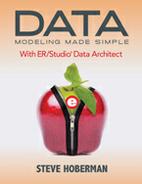Book Description
Data Modeling Made Simple with ER/Studio Data Architect (DA) will provide the business or IT professional with a practical working knowledge of data modeling concepts and best practices, along with how to apply these principles with ER/Studio DA. You'll build many ER/Studio DA data models along the way, applying best practices to master these ten objectives:
You will know why a data model is needed and which ER/Studio DA models are the most appropriate for each situation
You will be able to read a data model of any size and complexity with the same confidence as reading a book
You will know how to apply all the key features of ER/Studio DA
You will be able to build relational and dimensional conceptual, logical, and physical data models in ER/Studio DA
You will be able to apply techniques such as indexing, transforms, and forward engineering to turn a logical data model into an efficient physical design
You will improve data model quality and impact analysis results by leveraging ER/Studio DA's lineage functionality and compare/merge utility
You will achieve enterprise architecture through ER/Studio DA's repository and portal functionality
You will be able to apply ER/Studio DA's data dictionary features
You will learn ways of sharing the data model through reporting and through exporting the model in a variety of formats
You will leverage ER/Studio DA's naming functionality to improve naming consistency
This book contains four sections:
Section I introduces data modeling and the ER/Studio DA landscape. Learn why data modeling is so critical to software development and even more importantly, why data modeling is so critical to understanding the business. You will also learn about the ER/Studio DA environment. By the end of this section, you will have created and saved your first data model in ER/Studio DA and be ready to start modeling in Section II!
Section II explains all of the symbols and text on a data model, including entities, attributes, relationships, domains, and keys. By the time you finish this section, you will be able to 'read' a data model of any size or complexity, and create a complete data model in ER/Studio DA.
Section III explores the three different levels of models: conceptual, logical, and physical. A conceptual data model (CDM) represents a business need within a defined scope. The logical data model (LDM) represents a detailed business solution, capturing the business requirements without complicating the model with implementation concerns such as software and hardware. The physical data model (PDM) represents a detailed technical solution. The PDM is the logical data model compromised often to improve performance or usability. The PDM makes up for deficiencies in our technology. By the end of this section you will be able to create conceptual, logical, and physical data models in ER/Studio DA.
Section IV discusses additional features of ER/Studio DA. These features include data dictionary, data lineage, automating tasks, repository and portal, exporting and reporting, naming standards, and compare and merge functionality.
Table of Contents
- Contents at a Glance
- Contents
- Read me first!
- Section I: Overview
- Chapter 1: Data Model Overview
- Chapter 2: ER/Studio Functionality
- Chapter 3: ER/Studio Landscape
- Section II: Data Model Objects
- Chapter 4: Entities
- Chapter 5: Submodels
- Chapter 6: Attributes and Domains
- Chapter 7: Relationships
- Section III: Conceptual, Logical, and Physical Data Models
- Chapter 8: Conceptual Data Models
- Conceptual Data Model Explanation
- Relational and Dimensional Conceptual Data Models
- Creating a Conceptual Data Model
- Exercise 8.1: Creating a Conceptual Data Models in ER/Studio
- Exercise 8.3: Segmenting the Publisher CDM into Submodels
- Exercise 8.4: Creating a Conceptual Data Model for Your Organization
- Chapter 9: Logical Data Models
- Chapter 10: Physical Data Models
- Physical Data Model Explanation
- Relational and Dimensional Physical Data Models
- Creating a Physical Data Model in ER/Studio
- Denormalization
- Denormalizing in ER/Studio
- Exercise 10.1: Denormalizing in ER/Studio
- Views
- Views in ER/Studio
- Exercise 10.2: Creating Views in ER/Studio
- Indexing
- Indexing in ER/Studio
- Exercise 10.3: Indexing in ER/Studio
- Partitioning
- Partitioning in ER/Studio
- Exercise 10.4: Partitioning in ER/Studio
- Exercise 10.5: Tracing from Physical back to Logical
- Chapter 8: Conceptual Data Models
- Section IV: Additional ER/Studio Features
- Chapter 11: Data Dictionary
- Importing a Data Dictionary
- Types of Objects Imported from a Data Dictionary
- Domains
- Domains in ER/Studio
- Exercise 11.1: Creating Domains in ER/Studio
- User-Defined Datatypes
- User-Defined Datatypes in ER/Studio
- Exercise 11.2: Creating User-Defined Datatypes in ER/Studio
- Reference Values
- Reference Values in ER/Studio
- Exercise 11.3: Creating Reference Values in ER/Studio
- Attachments
- Attachments in ER/Studio
- Exercise 11.4: Creating Attachments in ER/Studio
- Chapter 12: Data Lineage
- Chapter 13: Macros
- Chapter 14: Importing, Exporting, Printing, and Reporting
- Chapter 15: Naming Standards
- Chapter 16: Compare/Merge Utility
- Chapter 11: Data Dictionary
- Appendix A: References
- Appendix B: Answers to Exercises
- Appendix C: Glossary
- Appendix D: ERStudio Commands Quick Reference
- Index
